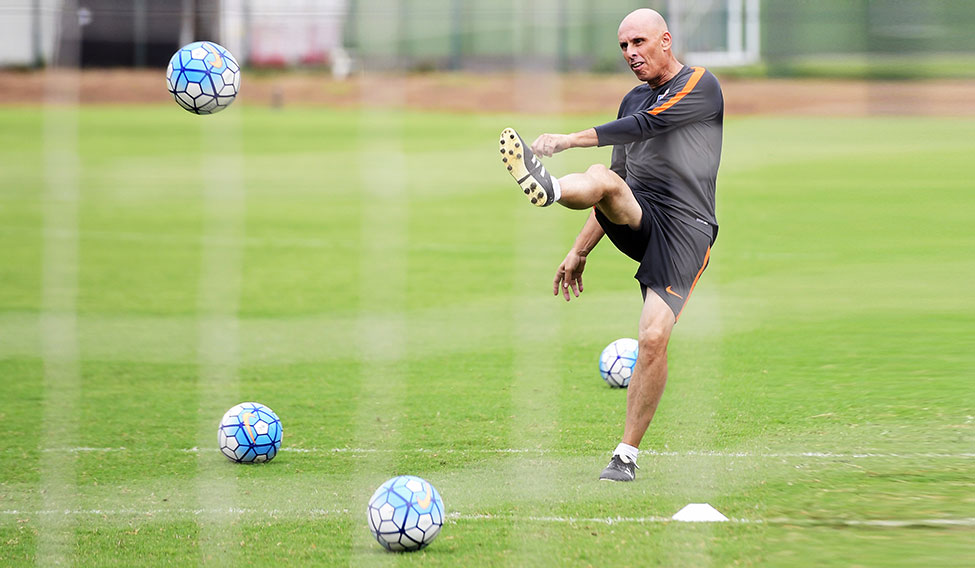In March 2015, the Indian team had hit a historical low of 173 in the FIFA world rankings. Since then, it has come a long way; its performance has steadily improved and its international participation significantly increased. Over the last few months, the team has enjoyed a dream run, winning matches and climbing up the rankings. As per FIFA’s latest monthly update, India was ranked 97, on August 10; its highest ever ranking was 94, in February 1996.
The driving force behind the team’s performance is coach Stephen Constantine. A former player from England, Constantine was appointed men’s national team coach in March 2015, after his first 2002-2005 stint. On his return, there were remnants from his previous stint, there was complacency and players were training only once a day.
The team is currently on a winning streak, having won three consecutive away games, a feat Constantine says is unprecedented. The last few wins have put India on the right path of achieving qualification for the 2019 AFC Asian Cup. After the qualifier in June against Kyrgyzstan, skipper Sunil Chhetri, the solitary scorer with a stunning run and finish, called it one of the team’s best performances in his 12-year national career.
Having substantially increased the team’s bench strength, 32 players have made their debut under his watch. He is at the helm of the All India Football Federation’s (AIFF) talent search programmes, and has reduced the average age of players from 30 years to 24.
Constantine, who also coaches the U-23 national team, told THE WEEK that he has one message for team aspirants: “If you can give me what I want from you, I will get it out of you; if you can’t, then I don’t need you.”
Excerpts from an interview with the man who is leading Indian football through its golden period:
How did you take Team India from 173 to 97 in the FIFA World Rankings?
The AIFF has been extremely supportive and really gave me a free hand. I have adequate support staff, better technology, and the team now stays in better hotels. It is expensive but all these aspects relate to the mentality of the players; they appreciate how they are treated and respected.
We needed to ensure that the team was respected by other national teams, and the only way to do that was by beating them. The more games it plays, the higher the chances of climbing up the rankings.
The players have been fantastic. I have been very hard on them. I tell them that I don’t care what they do in their clubs. Here, they are the national team and need to fight till the last drop of blood.
Which were the games that showed the team was improving?
I was really pleased with my first home game against Oman (June 2015), though we lost 2-1. It showed me that the players were capable of doing what I wanted.
How did you create a healthy bench strength?
When I arrived, the average age of the national team was about 30 years. For international football, that is very old. We set up a scouting network. It doesn’t matter where a player is playing. If he can add value to the team, he will be in. On June 6, in the Nepal friendly match, our 32nd player Jerry Lalrinzuala made his debut. He is 18 years old. Daniel Lalhlimpuia is 19 years old. The future is bright. The person who takes over from me will have a ready-made squad for the next five years.
Are you happy with the number of international matches?
Yes. For the first time, we have confirmed games six months in advance. Planning ahead is essential. That is why we need a national team calendar, so that clubs can slot their games accordingly and everybody is happy.
How crucial is it to qualify for the 2019 AFC Asian Cup?
It would be a huge step in the right direction; to say we belong. We are in a decent position. In the past two years, we have learnt how to compete. Now, we have to learn how to qualify. I don’t think you can say one particular tournament will decide my future or India’s. We have to do it on a regular basis now. There’s no good doing it once and then not doing it for years.
Of the players you brought in, who do you think will serve India in the long run?
I think they would be Jeje Lalpekhlua, Rowllin Borges, Sandesh Jhingan, Vikas Naidu and Sumit Passi. Now, there are so many new players; the older players keep looking over their shoulders.
Are players doing what you tell them to when they are with their clubs?
No, they are not able to. This is why I need 10-15 days with them—not 5 days—before a match, to get them into physical condition.
You had criticised the ISL and clubs for not releasing players for national camps. Now, you appear happier with the situation.
A lot has changed since then. IMG-Reliance [which runs the ISL] invited me to discuss my vision. I said that Indian football would never get the attention it deserved until the national team began playing well. If they wanted the ISL to be accepted, the window was the national team. They have listened, and now there is a genuine effort to help the national team get the best players, and give them enough time for preparation.
Are you happy that your demand for more Indian players in the ISL is likely to be accepted?
Yes. I have been requesting that for two and a half years! I am not against foreign players. They can increase the levels and the quality, but should come with the right intent and contribute [to improving the team].







